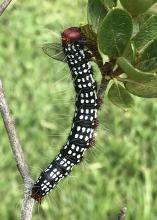Information Possibly Outdated
The information presented on this page was originally released on March 13, 2023. It may not be outdated, but please search our site for more current information. If you plan to quote or reference this information in a publication, please check with the Extension specialist or author before proceeding.
Azalea blooms give an early-spring show
Azaleas are starting to produce their beautiful flowers in my landscape, and it is a welcome sight after a few months of cold weather.
Like many of your azaleas, mine had some tender, new growth that suffered cold damage from the freezing temperatures we got last December. I hope you did the right thing and did not do any pruning to your azaleas yet.
You should only prune azaleas after they have finished blooming in the late winter or early spring. If you went ahead and pruned to remove freeze damage, you pruned off potential blooms.
Did you know there are evergreen and deciduous azaleas? I have a mixture of both in my yard.
Most evergreen azaleas originated from Japan, China, Taiwan and Korea. Mississippi has several deciduous azaleas that are native, but some originated in Eastern Europe and several Asian countries.
Evergreen azaleas are more popular for use in the home landscape, but deciduous azaleas are great plants for woodland landscapes.
Over the years, azalea breeding programs have developed some awesome new cultivars. Encore Azaleas are among the most popular varieties on the market now.
Unlike traditional azaleas, Encore Azaleas bloom multiple times throughout the year. They do well in U.S. Department of Agriculture zones 6-10, which includes all of Mississippi. Encore Azaleas will grow in full sun, but I have seen the best-looking examples growing in part sun to part shade.
One of my favorite Encore Azaleas is Autumn Bonfire, known scientifically as Rhododendron Robleza.
This is a fast-growing dwarf azalea with beautiful red, semidouble blooms that appear in spring, summer and fall. With its foliage that stays a dark evergreen year-round, this azalea is excellent for borders and mass plantings. Autumn Bonfire can grow up to 3 feet tall and 3.5 feet wide, so keep that in mind when deciding where to plant this shrub in your landscape.
In general, most azaleas are hardy plants with few disease and pest issues. Azalea caterpillars can quickly eat the leaves from plants, but new leaves will sprout. If you see caterpillars on your azaleas, the best method of control is to remove them by hand. If you’d rather not handle them, there are several pesticides that can be sprayed to control caterpillars.
An insect you do want to watch for is the azalea lace bug. These pests live and feed on the underside of leaves, removing sap and chlorophyll-containing tissues. This damage causes the leaf surface to become bleached, yellowed and stippled from the nutrient deficiency.
You can contact your local county office of the Mississippi State University Extension Service or visit for recommendations on how to control lace bugs.
[EDITOR’S NOTE: Dr. Eddie Smith is the Mississippi State University Extension agent in Pearl River County and a Southern Gardening guest columnist.]






